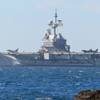Uncharted Waters: Mega-cruise Ships Ply Arctic Waters
First luxury cruise sailed Northwest Passage in Aug-Sept; Voyage will be repeated next summer.
A surge in Arctic tourism is bringing ever bigger cruise ships to the formerly isolated, ice-bound region, prompting calls for a clamp-down to prevent Titanic-style accidents and the pollution of fragile eco-systems.
Arctic nations should consider limiting the size of vessels and ban the use of heavy fuel oil in the region, industry players said, after a first luxury cruise ship sailed safely through Canada's Northwest Passage this summer.
The route, which connects the Atlantic and Pacific Oceans via the Arctic, was once clogged with icebergs but is now ice-free in summer due to global warming.
With a minimum ticket price of $19,755, the 1,700 passengers and crew on board the Crystal Serenity followed - in reverse - the route first navigated more than a century ago by Norwegian explorer Roald Amundsen. They left Anchorage in Alaska on Aug. 15 and docked in New York on Sep. 16.
The ship's operator, Crystal Cruises, says on its website it will repeat the voyage in 2017. It declined a request for comment when contacted by Reuters.
Two shipping executives expressed concern that the one-off trip could become a trend, citing worries over safety, risks to the environment and the impact on small communities, in an area where there is no port between Anchorage and Nuuk, in Greenland.
"The Northwest Passage is thousands and thousands of nautical miles with absolutely nothing ... There is a need to discuss possible regulation," said Tero Vauraste, the CEO of Arctia, a Finnish shipping firm specialising in icebreakers.
Were a ship to be in trouble in the Northwest Passage, there would be little authorities could do given the lack of infrastructure, he said.
"So we must do everything we can do to prevent this," said Vauraste, who is also vice-chair of the Arctic Economic Council, a regional forum for business cooperation between Arctic nations.
Navigation in icy waters is made more difficult by poor satellite imagery. "An ice field might move at a speed of 4-5 knots, but a ship will receive a satellite picture of it that is 10-20 hours old," said Vauraste. "We need better quality imagery."
HEAVY OIL
Another concern is environmental. "Potentially, an accident involving a mega-ship could represent an environmental disaster," said Daniel Skjeldam, CEO of Hurtigruten, a cruise ship operator in the Arctic and the Antarctic, whose biggest ships can accommodate 646 passengers.
Cruise ships usually use heavy oil, a type of fuel that takes longer to break down in the event of a spill. The Crystal Serenity did not use heavy oil during its trip, its operator has said.
"Heavy oil in cold conditions is sticky and takes much longer time to break down so it has a prolonged effect on the environment," said Marco Lambertini, director-general of World Wildlife Fund International.
"If something happens at the beginning of winter, no cleanup can be done. Oil can get trapped under the ice and travel for a hundred kilometres," he told Reuters.
A U.N. polar code will come into effect in 2017 which toughens demands on ship safety and pollution. It bans heavy fuel oil in the Antarctic, for instance, but merely encourages ships not to use it in the Arctic.
"What I call for is stronger regulations coordinated between the Arctic nations," Hurtigruten's Skjeldam told Reuters. He suggested the size of ships should be limited, without specifying by which criteria, that the use of heavy oil be banned and shipping companies should aim to reduce their emissions by, for instance, using hybrid engines.
Vauraste said an update of the Polar Code, addressing some of these issues, could be on the agenda for the Arctic Economic Council.
The impact of the 'mega-ships' on small arctic communities is also becoming a concern.
Svalbard - an archipelago midway between Europe's northernmost point and the North Pole - is experiencing a tourism boom, with the number of overnight stays by visitors rising 14 percent in July year-on-year to 18,000.
"I stay home when the cruise ship tourists come. Too many people at the same time. It is really stressful," said Fredric Froeberg, 37, a Swedish guide who runs excursions on snow scooters and boats from Longyearbyen, Svalbard's main settlement, with around 2,160 inhabitants.
"This place should not become too big. Otherwise it will become overexploited, like so many other places around the world. What is fantastic here is the nature."
By Gwladys Fouche










